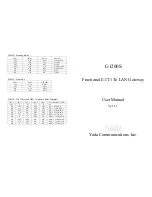
TD 92326GB
2009-03-10 / Ver. E
Installation and Operation Manual
VoIP Gateway
54
3
Click “OK”.
• Suppress HLC
Suppresses the transmission of “high layer compatibility”
information elements on the interface. See
Suppression of specific Protocol Elements
• Suppress FTY
Suppresses the transmission of “facility information
elements” on the interface. See
• Suppress Subaddress
Suppresses the transmission of “Subaddresses” on the
interface.
• Suppress Connected
Num.
No connected number information elements are
transmitted.
• No Restart
Suppresses the sending of RESTART messages.
A restart message requests the recipient to: return to an
idle condition, determine if there is a call present on the
channel, terminate each call found, and respond with an
Acknowledgement message.
• Passive Layer2
Normally the device tries to establish the link layer on
point to point interfaces as soon as the physical layer is
established. This behaviour is especially incompatible to
some ISDN conformance test equipment even if it
conforms to standard. This option turns this off.
• No overlap Receive
Suppresses a SETUP_ACK on incoming single digit
dialling on a point to multipoint connection, in TE mode.
See
Single Digit Dialling on Terminals on Point-to-
• No Disc
If set, incoming calls cannot be rejected (no DISC in
incoming call accepting status. REL is transmitted
instead.
• No Disc for Call Reject Call Rejection is done with REL message instead of DISC.
• Annex-N
Refers to the ETS 300 102 Annex-N. This allows in NT
mode inband tones to be sent on incoming calls before
connect (usually the network does not connect the B-
channel in this state).
• Volume
In some cases, it is desirable to adjust the basic volume
level of an interface. The volume of the ISDN interfaces
can be set in the range from -31 to +32. The units of the
volumes setting are Decibels. No entry, or the value 0
corresponds to the factory setting. A - entry reduces the
volume and a + entry increases the volume of the
associated interface.
• CR-Length
Call reference length, see
• CHI Type
Channel ID coding, see
















































